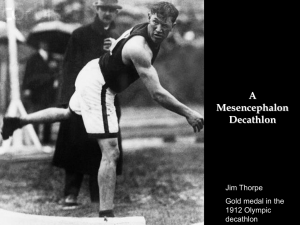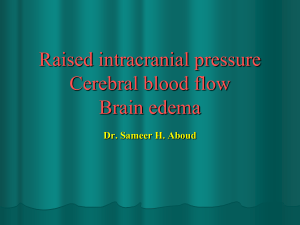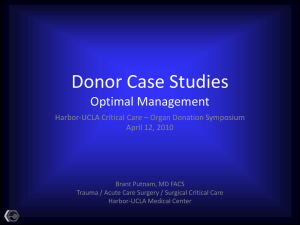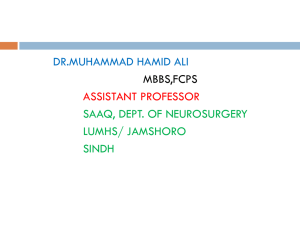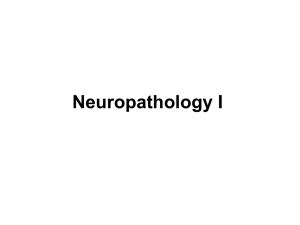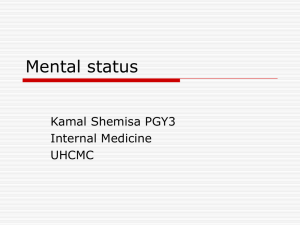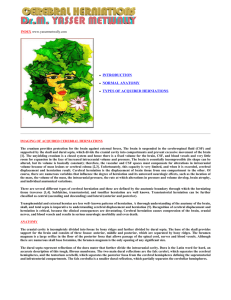CEREBRAL HERNIATION
advertisement
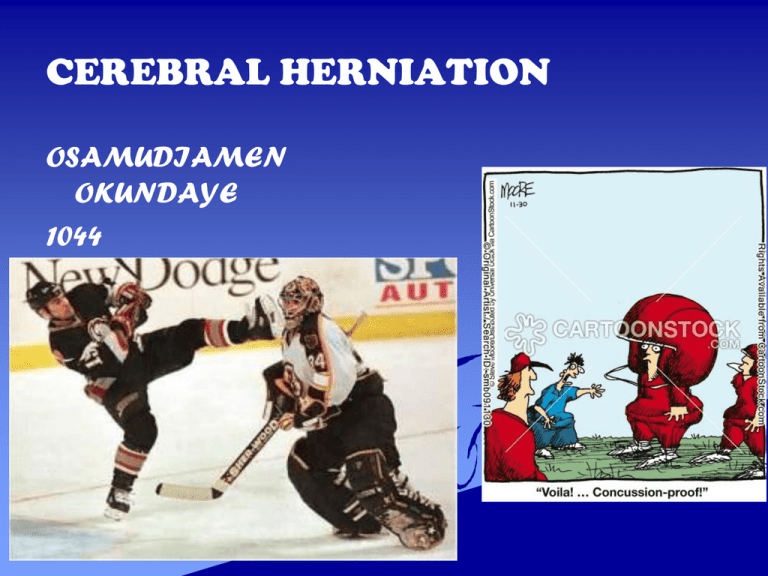
CEREBRAL HERNIATION OSAMUDIAMEN OKUNDAYE 1044 CASE STUDY • A previously healthy 51-year-old woman developed arm and leg weakness without paresthesias one week after a flu-like illness. One week after the weakness occurred, difficulty ambulating necessitated hospitalization. Neurologic examination revealed mild asymmetric upper greater than lower extremity weakness with normal cranial nerves, deep tendon reflexes, and sensation. Creatine kinase, ESR, and cerebrospinal fluid (CSF) cell count and protein were normal. An edrophonium test was negative. Nerve conduction studies revealed low motor amplitudes and normal sensory responses. Needle examination revealed reduced recruitment of normal motor unit potentials, but there was no spontaneous activity. CS Over another week, her weakness worsened and respiratory failure occurred. She underwent tracheal intubation and mechanical ventilation. There was facial and palatal weakness in addition to only a flicker of upper extremity movement and barely antigravity strength in the legs. Deep tendon reflexes were absent, but sensation remained normal. A brain CT scan was normal. The CSF contained 2 WBCs (1 PMN), and the protein rose to 54 mg/dl (normal less than 45). Nerve conduction studies revealed low motor and normal sensory responses in an arm and leg. There was no conduction block. An EMG needle examination was refused. Five days after intubation, sudden mental status deterioration occurred, and an intracerebral hemorrhage was identified on CT scan. The patient succumbed to brain herniation. She had received intravenous heparin for venous thrombosis prophylaxis due to a history of thrombophlebitis. CH CH Cerebral herniation is a potentially deadly side effect of very high intracranial pressure that occurs when a part of the brain is squeezed across structures within the skull. The brain can shift across such structures as the falx cerebri, the tentorium cerebelli, and even through the foramen magnum in the base of the skull (through which the spinal cord connects with the brain). Herniation can be caused by a number of factors that cause a mass effect and increase intracranial pressure (ICP): these include traumatic brain injury, intracranial hemorrhage, or brain tumor. CH Herniation can also occur in the absence of high ICP when mass lesions such as hematomas occur at the borders of brain compartments. In such cases local pressure is increased at the place where the herniation occurs, but this pressure is not transmitted to the rest of the brain, and therefore does not register as an increase in ICP classifications of herniations There are two major classes of herniation: supratentorial and infratentorial. Supratentorial herniation is of structures normally above the tentorial notch and infratentorial is of structures normally below it. ch Supratentorial herniation 1.Uncal (transtentorial) 2.Central 3.Cingulate (subfalcine) 4.Transcalvarial CH Infratentorial herniation 5.Upward (upward cerebellar or upward transtentorial) 6.Tonsillar (downward cerebellar) CH Uncal herniation In uncal herniation, a common subtype of transtentorial herniation, the innermost part of the temporal lobe, the uncus, can be squeezed so much that it moves towards the tentorium and puts pressure on the brainstem, most notably the midbrain.The tentorium is a structure within the skull formed by the dura mater of the meninges. Tissue may be stripped from the cerebral cortex in a process called decortication. The uncus can squeeze the oculomotor nerve, which may affect the parasympathetic input to the eye on the side of the affected nerve, causing the pupil of the affected eye to dilate and fail to constrict in response to light as it should. Pupillary dilation often precedes the somatic motor effects of cranial nerve III compression, which present as deviation of the eye to a "down and out" position due to loss of innervation to all ocular motility muscles except for the lateral rectus (innervated by cranial nerve VI) and the superior oblique (innervated by cranial nerve IV). The symptoms occur in this order because the parasympathetic fibers surround the motor fibers of CNIII and are hence compressed first. CH CH • Compression of the ipsilateral posterior cerebral artery will result in ischemia of the ipsilateral primary visual cortex and contralateral visual field deficits in both eyes (contralateral homonymous hemianopsia) CH CH Central herniation In central herniation, the diencephalon and parts of the temporal lobes of both of the cerebral hemispheres are squeezed through a notch in the tentorium cerebelli.Transtentorial herniation can occur when the brain moves either up or down across the tentorium, called ascending and descending transtentorial herniation respectively; however descending herniation is much more common.[1] Downward herniation can stretch branches of the basilar artery (pontine arteries), causing them to tear and bleed, known as a Duret hemorrhage. CH The result is usually fatal.Other symptoms of this type of herniation include small, dilated, fixed pupils with paralysis of upward eye movement giving the characteristic appearance of "sunset eyes". Also found in these patients, often as a terminal complication is the development of Diabetes Inspidus due to the compression of the pituitary stalk. Radiographically, downward herniation is characterized by obliteration of the suprasellar cistern from temporal lobe herniation into the tentorial hiatus with associated compression on the cerebral peduncles. Upwards herniation, on the other hand, can be radiographically characterized by obliteration of the quadrigeminal cistern. Intracranial hypotension syndrome has been known to mimic downwards transtentorial herniation. CH • CINGULATE HERNIATION In cingulate or subfalcine herniation, the most common type, the innermost part of the frontal lobe is scraped under part of the falx cerebri, the dura mater at the top of the head between the two hemispheres of the brain.Cingulate herniation can be caused when one hemisphere swells and pushes the cingulate gyrus by the falx cerebri.This does not put as much pressure on the brainstem as the other types of herniation, but it may interfere with blood vessels in the frontal lobes that are close to the site of injury (anterior cerebral artery), or it may progress to central herniation. Interference with the blood supply can cause dangerous increases in ICP that can lead to more dangerous forms of herniation.Symptoms for cingulate herniation are not well defined.Usually occurring in addition to uncal herniation, cingulate herniation may present with abnormal posturing and coma.Cingulate herniation is frequently believed to be a precursor to other types of herniation. SUBFALCRINE HERNIATION ON CT CH Transcalvarial herniation In transcalvarial herniation, the brain squeezes through a fracture or a surgical site in the skull.Also called "external herniation", this type of herniation may occur during craniectomy, surgery in which a flap of skull is removed, preventing the piece of skull from being replaced. CH CH Upward herniation Increased pressure in the posterior fossa can cause the cerebellum to move up through the tentorial opening in upward, or cerebellar herniation.The midbrain is pushed through the tentorial notch. This also pushes the midbrain down. CH CH • Tonsillar herniation • In tonsillar herniation, also called downward cerebellar herniation,or "coning", the cerebellar tonsils move downward through the foramen magnum possibly causing compression of the lower brainstem and upper cervical spinal cord as they pass through the foramen magnum.Increased pressure on the brainstem can result in dysfunction of the centers in the brain responsible for controlling respiratory and cardiac function.The most common signs are head tilt and neck stiffness due to tonsillar impaction. The level of consciousness will decrease and also give rise to flaccid paralysis. Blood pressure instability is also evident in these patients. CH • There are many suspected causes of tonsillar herniation including: decreased or malformed posterior fossa (the lower, back part of the skull) not providing enough room for the cerebellum; hydrocephalus or abnormal CSF volume pushing the tonsils out. Connective tissue disorders, such as Ehlers Danlos Syndrome, can be associated. CH Signs and symptoms. Decorticate posturing, with elbows, wrists and fingers flexed, and legs extended and rotated inward Brain herniation frequently presents with abnormal posturing a characteristic positioning of the limbs indicative of severe brain damage. These patients have a lowered level of consciousness, with Glasgow Coma Scores of three to five.One or both pupils may be dilated and fail to constrict in response to light. Vomiting can also occur due to compression of the vomiting center in the medulla oblongata. Treatment and prognosis, Treatment involves removal of the etiologic mass and decompressive craniectomy. Brain herniation can cause severe disability or death. In fact, when herniation is visible on a CT scan, the prognosis for a meaningful recovery of neurological function is poor.[2] The patient may become paralyzed on the same side as the lesion causing the pressure, or damage to parts of the brain caused by herniation may cause paralysis on the side opposite the lesion.[8] Damage to the midbrain, which contains the reticular activating network which regulates consciousness, will result in coma.[8] Damage to the cardio-respiratory centers in the medulla oblongata will cause respiratory arrest and (secondarily) cardiac arrest.[8] Current[when?] investigation is underway regarding the use of neuroprotective agents during the prolonged post-traumatic period of brain hypersensitivity associated with the syndrome. MRI SHOWING DAMAGE DUE TO HERNIATION CH
